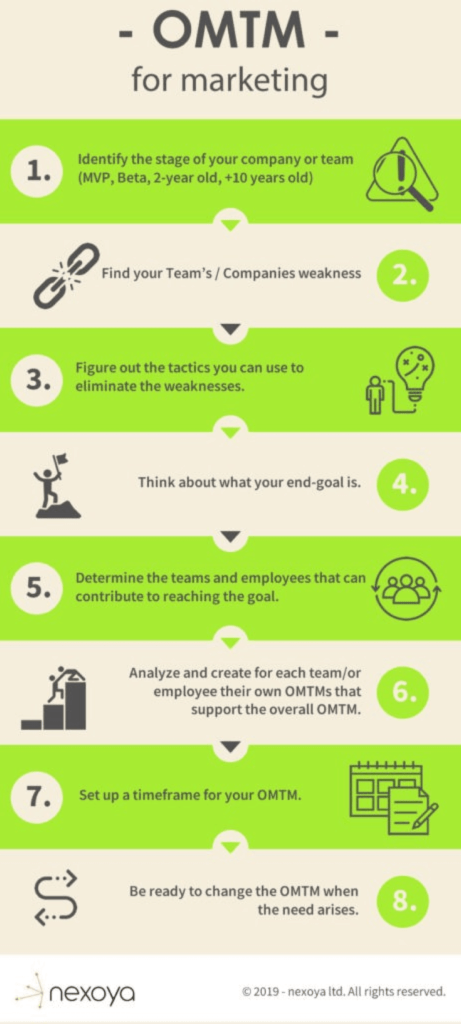Nowadays there are plenty of various marketing strategies and tactics which companies can apply. Usually most of the “traditional” marketing strategies implies tracking and evaluating several metrics at the same time. However, the more kpi metrics the strategy has the harder it can start evaluating them. Consequently, it can result in ambiguity of events and misunderstandings for team members.
Moreover, sometimes for a marketing team it can be hard to define metrics that really matter. It is indeed not that easy as it may seem from the first sight.
Then the question of prioritization is becoming crucial: which kpi metric is the most relevant? Which one can be ignored?
That is why such concept as “One Metric That Matter” is becoming more and more popular in the marketing sphere.
One Metric That Matters (short OMTM) is a concept, with the idea that your whole team or company focuses on one metric only at a particular time.
If you want to know how to define your One Metric That Matter and what to take into account while working towards reaching your OMTM in the context of your marketing strategy, you are in the right place.
Why you should not ignore OMTM
OMTM brings a lot of clarity and certainty not only into marketing strategy, but also into the team’s and the company’s spirit. When there is a clearly identified goal to reach and the employees know, towards what all their efforts are leading to, it does not only bring team motivation but also work transparency and structure in the daily work. Moreover, “One Metrics That Matter” approach fosters the creativity of the whole team towards finding new and different ways on how to get there – with the one kpi metric in mind.
Simply said: Focusing on one single goal can help to lower unproductivity, distribute efforts towards the right tactics and avoid wasting any energy on irrelevant goals which may be important but actually not critical. That is why OMTM especially important for small and medium size companies.

What is important to think about before defining your OMTM?
There are no golden rules on how to define the right “One Metric That Matter” (OMTM), but various aspects need to be considered by you before:
- What Industry are you in? (can change the OMTM heavily – quality vs. quantity considerations as an example)
- Who is your target audience? (I.e. B2C or B2B)
- What is your business model?
- For whom is the OMTM? (For the whole company or your marketing team or even just for a project?)

1. What’s your company’s status?
Before starting any discussion, it is important to consider the stage your company is in: fresh startup, MVP, BETA, 3-year old startup, 6- year old company or an established corporation. Why is this important? It is crucial, because for each stage you need to apply different marketing strategy. The short term goals for 6 months old startups are totally different from that of a company that has been operating in its own field for years already.
2. Find your company’s weaknesses.
To define the metrics that matter you need to define what is the potential “bottleneck” of your company’s marketing strategy. Start with a brainstorming session with your team and figure out your company’s weak points.
3. Tactics to reduce your weakness.
Next, would be to think about the tactics on how to diminish or liquidate these points or turn them into a positive factor for the company. Here, you are on a short-term, and more tactical level. The goal is to come up with a list of potential actions. Basically, at this stage you are setting the metrics that matter for your company and that you want to track regularly.
4. Strategies – think about your end-goal.
What is the main goal of your marketing strategy? At this stage the priorities should be settled. Which is the most important goal that needs to be achieved within the next 1-2 years? Discuss this with the team; now you are in a long-term thinking discussion. After finding the end-goal, analyze and brainstorm with your team members what it would take to reach this goal: what kpi metric can help you to track the progress. As an example: Your end-goal is to get 50 new customers by the end of the year. Therefore, you have to set up your “One Metric That Matter” (OMTM) to be customer acquisition.
5. Team contribution:
Determine the teams and employees that can contribute to reaching the goal. Now, after you have identified “One Metric That Really Matter” (OMTM), think about the teams and employees; how can they assist and contribute to reaching the OMTM?
What is important: The whole team is responsible for it from the start.
6. Distribution within the team.
As a next step, you want to set up an OMTM for each team or employee, that supports the overall OMTM. This way, the work is distributed in the most favourable manner in order to attain the set objective. It is totally fine for the employees to have the same personal OMTM as the company. This is totally fine. When you’re doing it for the first time, you can decide to skip this point and just focus on the Team’s OMTM first.
7. Reporting:
Set up a regular reporting schedule for your OMTM. After the OMTM for your company is defined, set up regular reporting sessions that will help you to evaluate the status of your OMTM. This ensures that the OMTM is always in everyone’s mind. For example, if your goal was to reach your OMTM within 6 months, you should create monthly reports and analyze the probability of reaching that goal through short sessions every month with that theme.
8.Flexibility:
your One metric that matters (OMTM) will change. While your team executes towards the one metric that matters, the OMTM will most likely be challenged and maybe will have to change depending on the stage your team/company or project is on and on your marketing strategy. This is totally ok as long as everybody is aligned to it. After a certain period of time, it is also important to re-evaluate the objectives and define another “one metric that matters”.
Examples of OMTM’s for Marketing
Here is a short-list of examples of OMTM’s that Marketing Teams mostly apply:
- Sales
- Conversions
- Submissions
- Cost-per-acquisition (CPA)
- Retention
Important to reflect: the whole team would always focus on one metric solely. As a responsibility, you obviously need to keep an eye on the other KPIs (key performance indicators) and be ready to initiate the re-evaluation of your OMTM with the team.
We are happy to keep you updated!
Learn more about 5 important AI practices in E-commerce and SEO tactics for 2019!